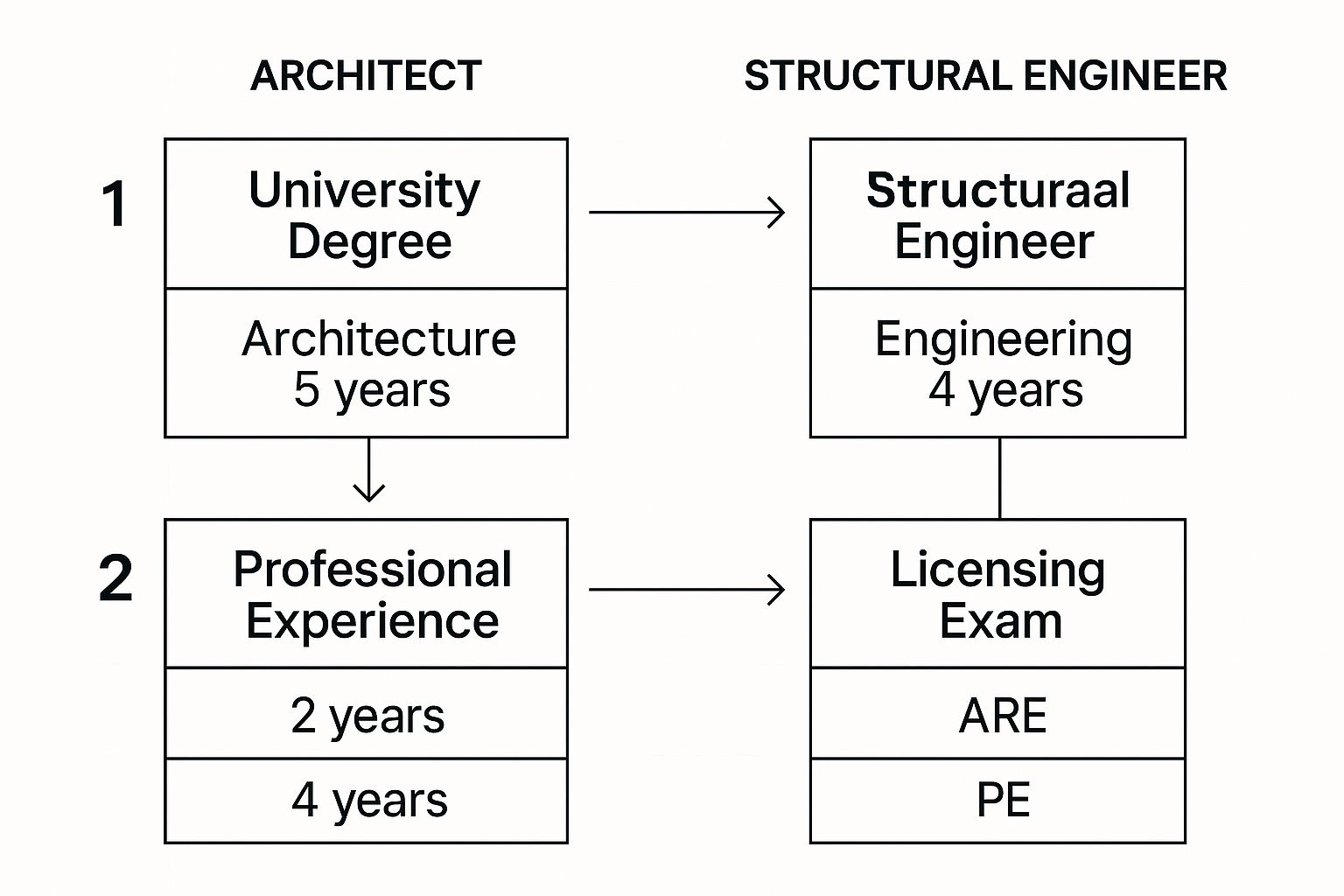Structural Engineer vs Architect: Which Do You Need?
- Harper Latter Architects

- Sep 14
- 13 min read
Updated: Sep 15
When you’re planning a major home project, one of the first questions that comes up is: who do you hire first? The debate over a structural engineer vs an architect often boils down to a simple idea: vision versus physics.
Architects are the creative force, the ones who focus on aesthetics, the flow of your home, and how you’ll actually experience the space day-to-day. Structural engineers, on the other hand, are the scientific experts, entirely focused on safety, strength, and the structural integrity of the building.
Understanding Architect and Structural Engineer Roles
Embarking on a luxury residential project in the UK means getting to grips with the distinct, yet complementary, roles of an architect and a structural engineer. While both are absolutely fundamental to any build, they approach the project from completely different angles, each bringing a unique and vital set of skills to the table.
Think of an architect as the master planner of your project. They are professionally trained to translate your lifestyle and aspirations into a design that is both beautiful and perfectly functional. Their role covers a huge spectrum of responsibilities, including:
Creative Vision: Developing the overall look and feel, the layout, and the user experience of your home.
Spatial Planning: Making sure rooms flow logically and that every square metre is optimised for daily living.
Regulatory Compliance: Navigating the complexities of UK planning permission and building regulations.
Project Coordination: Often acting as the lead consultant, they manage and coordinate the other professionals involved.

In contrast, a structural engineer’s role is rooted in science and mathematics. They are the ones legally responsible for ensuring the building is safe, stable, and will stand the test of time. They take the architect’s creative vision and work out exactly how to build it so it can withstand physical forces like gravity, wind, and the weight of the structure itself. Their work is highly specialised and intensely technical.
Here’s a practical example: your architect designs a stunning open-plan living area with huge glass doors and no visible columns. It’s the structural engineer who then calculates the precise size and specification of the hidden steel beams needed to support the floors above. One professional imagines what’s possible; the other makes it physically achievable.
Architect vs Structural Engineer At a Glance
For a quick overview, this table summarises the key differences between an architect and a structural engineer in a typical UK residential project. It breaks down their focus, responsibilities, and the main things they'll produce for you.
Aspect | Architect | Structural Engineer |
|---|---|---|
Primary Focus | Aesthetics, function, spatial design, and user experience. | Safety, stability, strength, and structural integrity. |
Core Skills | Creative design, planning regulations, project management. | Physics, mathematics, material science, load calculations. |
Key Deliverables | Concept sketches, detailed architectural drawings, planning applications. | Structural calculations, steel beam specifications, foundation plans. |
When to Hire First | For new builds, extensions, and major refurbishments where design is key. | For specific tasks like removing a load-bearing wall or assessing a structural issue. |
Ultimately, while their roles are distinct, the best projects see them working in close collaboration. The architect’s vision is made buildable by the engineer's calculations, creating a home that is both beautiful and structurally sound.
Professional Qualifications and Expertise in the UK
To really get to the heart of the architect vs. structural engineer debate, you have to look at how they’re trained. Their educational paths in the UK are long, demanding, and fundamentally different, which is precisely what shapes their distinct expertise and approach on a project.
An architect’s qualification is a serious commitment, blending creative vision with a deep understanding of the technical side of construction. It takes a minimum of seven years to become a fully qualified architect, a journey that involves university degrees and a great deal of hands-on, practical experience. Everything is overseen by the Architects Registration Board (ARB), the official body that regulates the profession in the UK.
The Architect's Path to Registration
The standard route to getting your name on the ARB register is broken down into three key stages:
Part 1: An ARB-recognised undergraduate degree in architecture. This is the creative and theoretical foundation.
Part 2: A two-year, full-time postgraduate degree, usually a Master of Architecture (MArch), which dives much deeper into complex design challenges.
Part 3: A final qualifying exam, which you can only sit after logging at least 24 months of professional experience in the field.
This intensive training is all about creating professionals who can masterfully shape space. They learn about everything from planning laws and project management to human-centric design, equipping them to create buildings that are not just beautiful but also truly functional.
The Structural Engineer's Journey to Chartership
A structural engineer’s education, on the other hand, is built on a bedrock of mathematics, physics, and materials science. Their ultimate goal is to achieve Chartered Engineer (CEng) status—a highly respected qualification that signals top-tier professional competence.
The journey usually starts with a degree in civil or structural engineering. This is followed by years of structured, on-the-job development and a final, rigorous review by a professional body like the Institution of Structural Engineers (IStructE) or the Institution of Civil Engineers (ICE). Their expertise isn't in shaping space, but in making sure that space can stand up safely by analysing forces, calculating loads, and guaranteeing a building's absolute stability.
At its core, the difference is this: an architect is trained to shape space for human experience, while a structural engineer is trained to make sure that space can safely exist within the laws of physics.
A quick look at the workforce numbers in the UK shows just how specialised these roles are. Recent data shows there are around 94,300 civil engineers (a category that includes structural engineers) working across the country. In contrast, the architecture profession is smaller but still a major force in the market. This difference in numbers really highlights their distinct, focused roles within the broader construction industry. If you're interested in the stats, you can explore more data about UK civil engineers on Statista.com.
Navigating Your Project From Concept to Completion
When you’re embarking on a high-end residential project, understanding who does what—and when—is key. It’s a journey from a creative idea to a physical reality, and while architects and structural engineers work closely together, their leadership and focus shift as the project unfolds.
Let's walk through the key stages of a typical home renovation or extension to see how this collaboration plays out.
Conceptual Design and Planning Permission
This first phase is firmly the architect's territory. Your journey begins here, in meetings where you'll discuss your vision, lifestyle, and what you hope to achieve. The architect takes these conversations and translates them into tangible sketches, floor plans, and 3D models that capture the aesthetic and functional heart of your home.
More than just a designer, the architect is your strategic guide through the complexities of local planning policies. They are responsible for preparing and submitting the planning application, handling all the correspondence with the council, and making any design tweaks needed to secure approval. The structural engineer’s input at this point is minimal; the focus is squarely on form, space, and getting that all-important permission.
Technical Design and Building Regulations
Once planning is granted, the project gets serious. This is the technical design stage, and it’s where the architect and structural engineer become a tightly integrated team. The architect develops the detailed drawings that the builders will eventually work from, but these plans need rigorous structural backing to gain Building Regulations approval.
It’s the architect who formally brings the structural engineer on board, handing over the approved designs. The engineer then gets to work, analysing the plans to produce all the necessary structural calculations and drawings.
For instance, the architect might design a dramatic cantilevered balcony. It’s the engineer’s job to then specify the essential reinforcement and steelwork required to make it structurally sound and safe for you and your family to enjoy.
This is a critical back-and-forth. The engineer’s calculations ensure the creative vision is not just achievable but also safe and fully compliant with building codes. Their work is woven directly into the architect’s final technical drawings. To get a better feel for how these stages fit together, you can explore [our process](https://www.harperlatterarchitects.co.uk/our-process) for delivering bespoke architectural projects.
This infographic shows the distinct yet demanding journeys both professionals undertake to become qualified in the UK.

As you can see, both professions require a huge investment in education and practical experience, which is why their specialised expertise is so valuable at different stages of a project.
Construction and On-Site Works
When the build begins, the architect often steps into the role of contract administrator. They become your eyes and ears on-site, overseeing the construction to make sure it aligns perfectly with the design intent, quality standards, and schedule. They are your main point of contact, managing the relationship with the builder and certifying payments.
The structural engineer’s involvement becomes more periodic, but it’s no less crucial. They will be called to the site at key milestones to inspect critical structural elements—usually just before they are covered up. This includes:
Inspecting foundations before the concrete is poured.
Checking the installation of steel beams or complex timber frames.
Verifying reinforcement in concrete slabs and retaining walls.
These inspections ensure the on-site work is a true reflection of their designs, guaranteeing the building's long-term safety and integrity. In short, the architect oversees the holistic vision, while the engineer validates the structural skeleton holding it all up.
Analysing Costs and Professional Fee Structures
Getting a handle on the financial side of your project is essential, and the way architects and structural engineers charge for their time really highlights their different roles. When you compare a structural engineer vs architect on cost, you're essentially looking at the difference between a project-wide leader and a highly specialised consultant.
Architects generally calculate their fees in a couple of ways. The most common approach is a percentage of the total construction cost, which for high-end residential projects in the UK, typically falls between 8% and 15%. Another option is a fixed lump-sum fee, which is often broken down and invoiced at key project stages. This all-encompassing fee covers their deep involvement, from the very first concept sketches and planning applications right through to being on-site to oversee construction.

Structural engineers, on the other hand, work on a much more focused basis. You’ll find their fees are either an hourly rate – usually somewhere between £45 and £65+ – or a fixed lump sum for a very specific, clearly defined piece of work. This might be a set of calculations for a steel beam, the design for a new foundation, or a few crucial site inspections. Their costs are tied directly to the technical brainpower required, not the overall project value.
Comparing Fee Structures in Practice
To see how this plays out in the real world, let’s imagine you're planning a £500,000 luxury home extension.
Architect's Fee (at 10%): You could expect the architect’s fee to be around £50,000. This reflects their long-term commitment and responsibility for the entire design and management process.
Structural Engineer's Fee: The engineer might need 20-30 hours for their calculations, drawings, and inspections. This would result in a fee somewhere between £1,500 and £3,000.
The huge difference is because the architect is your main partner for the entire journey, while the engineer provides critical, but targeted, technical input at specific moments. If you want a more detailed breakdown, our guide to the cost of an architect in the UK is a great place to start.
The fundamental difference in fees comes down to scope. An architect’s cost reflects their holistic management and design of the entire project lifecycle, whereas an engineer's fee is for a specialised, technical service within that project.
Salary patterns across the UK also tell a similar story. Recent reports show that architects are among the highest-paid trade professionals, with an average annual earning of £47,586. A structural engineer, in contrast, typically starts on a graduate salary of around £27,000. This climbs to about £45,000 once they become chartered, with senior positions reaching up to £80,000. These figures just go to show the different market values placed on their respective services.
Deciding Who to Hire for Your Specific Project
Knowing whether your first call should be to an architect or a structural engineer is key to starting your project on the right foot. The choice hinges on your primary goal: are you making a focused structural change, or are you completely reimagining a space?
To clear up any confusion, let’s walk through a few common scenarios homeowners face. This practical approach removes the guesswork, ensuring you match your project's core need to the right professional from day one for a smoother, more logical process.
Scenario 1: Removing an Internal Load-Bearing Wall
If your project is this specific and self-contained, your first – and often only – point of contact should be a structural engineer.
Your goal here is purely structural. An engineer will assess the wall, calculate the loads it supports, and provide precise drawings and calculations for the correct steel beam (RSJ) needed to replace it. These documents are essential for your builder and for securing Building Regulations approval. An architect’s input on spatial design simply isn’t needed for such a targeted job.
Scenario 2: Designing a New Two-Storey Extension
For a project of this scale, involving both new living space and significant structural work, you should always start with an architect.
The architect will collaborate with you to design the extension's layout, appearance, and how it connects to your existing home. They'll handle the planning permission application and craft the initial vision. Only once planning is secured will the architect bring in a structural engineer to design the foundations, roof structure, and any beams required to make their design a reality.
The core principle is simple: the architect leads the overall design and regulatory journey, while the engineer provides the essential structural expertise to support that vision. This ensures the final build is both beautifully designed and fundamentally safe.
Scenario 3: Investigating Foundation Cracks
When you find potential structural defects like major cracks in walls or foundations, you need an expert diagnosis. This is a job for a structural engineer.
They have the specialist expertise to assess the severity of the issue, identify the cause – like subsidence or material failure – and recommend a precise course of action. An engineer can produce a formal report and design the necessary repairs, giving clear instructions to specialist contractors. An architect isn't qualified to make this kind of technical assessment.
Scenario 4: A Complete Bespoke New-Build Home
For a project as comprehensive and design-led as a new home, an architect-led team is essential from the very beginning. The architect acts as your primary creative partner and project lead. They guide the entire process, from initial concept sketches to final completion, assembling and managing a team of consultants which will, of course, include a structural engineer.
Ultimately, the decision of who to hire is made simple by looking at your project’s main driver. If it’s a question of physics and safety, call an engineer. If it's about creating or transforming the space you live in, your journey begins with an architect. For more help at this initial stage, you can find valuable insights in our complete guide on how to choose an architect in the UK.
How Collaboration Delivers a Better Outcome
The distinction between a structural engineer and an architect isn't about rivalry; it’s about a vital partnership. The most successful high-end residential projects are born from seamless collaboration, where the architect’s creative vision is perfectly balanced with the engineer's technical solutions. This synergy is what transforms an ambitious concept into a beautifully realised, enduring home.
When these two professionals work in close partnership from the early stages, the entire project benefits. An engineer’s early input can help an architect refine an ambitious design, suggesting more efficient material use or subtle modifications that achieve the same aesthetic with greater structural integrity and potentially lower costs. This proactive teamwork prevents costly redesigns and delays down the line.

This collaborative spirit is particularly crucial as the UK's construction sector continues to expand. With projections of growth in residential completions, the demand for new and refurbished homes is rising, making efficient, well-integrated teamwork more important than ever. You can discover insights into the UK's architecture economic outlook on milientsoftware.com to explore this trend further.
Fusing Creativity with Physics
A truly integrated team ensures that creative ambition and physical laws work in harmony, not against each other. The result is a design that is both inspiring and intelligently constructed.
Innovative Problem-Solving: An architect might envision a floating staircase or a glass corner with no visible support. The engineer provides the sophisticated calculations and hidden framework to make it possible, turning a design feature into a feat of engineering.
Material Optimisation: The engineer can advise on the most effective materials to achieve the architect’s vision, balancing aesthetics with performance and budget. This could mean specifying a lighter, stronger steel or a sustainable timber alternative.
Smoother Construction: When structural and architectural plans are developed in unison, builders receive a clear, coherent set of instructions. This reduces ambiguity on-site, minimising errors and ensuring the project stays on schedule.
The ultimate goal of this partnership is to create a home where the structure doesn't just support the design but elevates it. The engineering becomes an invisible but essential part of the architectural story.
The Role of Modern Technology
Modern digital tools have completely changed this collaborative process for the better. Building Information Modelling (BIM) is a prime example, allowing architects and engineers to work on a shared 3D digital model of the project in real time.
With BIM, both professionals can see exactly how their work interacts. The architect can adjust a window placement, and the engineer can immediately assess its impact on a load-bearing wall, resolving potential conflicts long before they reach the construction site. This digital collaboration fosters a deeper understanding between the disciplines and leads to a more refined, efficient, and well-coordinated final outcome.
Frequently Asked Questions
When you're navigating a home renovation, it’s natural to have questions, especially when it comes to deciding between a structural engineer and an architect. Here are a few common queries we hear from UK homeowners, answered to give you a bit more clarity.
Do I Always Need Both an Architect and a Structural Engineer?
Not always. It really comes down to the scale and nature of your project.
If you’re planning a purely structural change, like removing a single internal load-bearing wall, a structural engineer can usually handle it all. They'll provide the necessary calculations and drawings you need to get the job done safely.
However, for anything more ambitious—a home extension, a loft conversion, or a complete new build—you’ll almost certainly need an architect on board first. For these projects, which involve new layouts, aesthetics, and planning permission, the architect leads the design and then brings in an engineer at just the right moment to work out the structural specifics.
Can an Architect Provide Structural Calculations?
While architects have a solid grasp of structural principles, they aren't qualified or insured to produce the detailed structural calculations required for Building Regulations approval here in the UK. That’s a legally protected role reserved for a qualified structural engineer.
The engineer's job is to calculate every load, specify the exact beam sizes, and design the foundations. This ensures your home isn't just compliant, but more importantly, that it's safe and built to last.
Who Is Responsible if Something Goes Wrong with the Structure?
Liability is clearly defined by each professional's role. The structural engineer is legally responsible for the safety and integrity of the structural elements they designed—think beams, columns, and foundations.
The architect, on the other hand, is responsible for the overall design, ensuring it meets planning and building regulations, and often for managing the building contract itself. Both professionals are required to have their own professional indemnity insurance to cover their specific areas of work.
What Is the Best Way to Find a Good Professional?
For architects, the Royal Institute of British Architects (RIBA) website is a fantastic resource, offering a searchable directory of accredited practices. For structural engineers, the Institution of Structural Engineers (IStructE) provides a similar database of its qualified members.
Don't underestimate the value of personal recommendations, either. Ask friends, family, or builders you trust for their suggestions. Whoever you consider, always take the time to look through their portfolio, speak to their references, and make sure their insurance is up to date before you appoint them.
Ready to bring your architectural vision to life with a team that understands the perfect blend of design and engineering? Contact Harper Latter Architects today for a consultation on your luxury residential project in South West London. Visit us at https://harperlatterarchitects.co.uk.

Comments